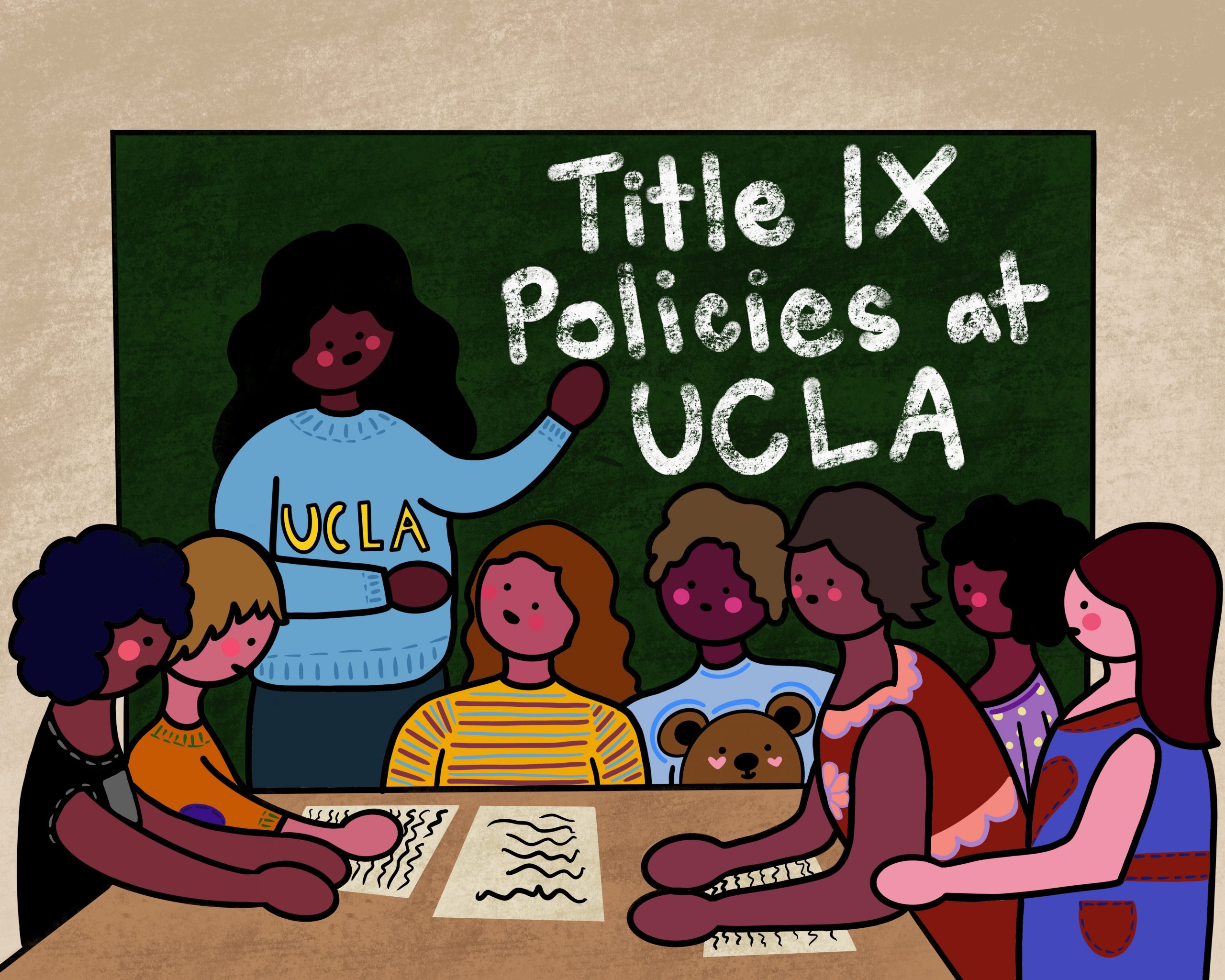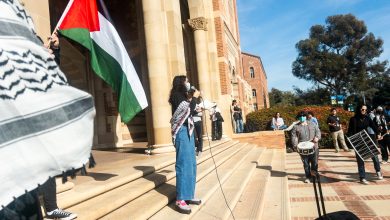The State of Title IX Reform at UCLA

Design by Erin Choi
Students gather around a desk while a teacher points to a chalkboard with the words “Title IX Policies at UCLA” written on it.
TW: discussion on sexual harassment, sexual violence, and harrassment
Title IX is a civil rights law which prohibits sex-based discrimination in any school or education program that receives funding from the federal government. Within the UC system, the Systemwide Title IX Office works to prevent and respond to incidents of sexual harassment and sexual violence faced by students. The UCLA Title IX Office offers resources and support services for survivors, as well as reporting and investigation procedures for incidents of sexual misconduct. However, most students only recognize the office for its annual training and education modules geared towards faculty, staff, and students to promote a safe and inclusive campus environment.
On campus, a Student Advisory Board (SAB) exists as the collaborative structure between students and campus Title IX offices: it strives to advise and provide student perspective on pertinent issues. As the UCLA undergraduate representative of the SAB, I have had my fair share of experiences deciphering the complex wording of Title IX legislation. Through my work perusing the semantics of Title IX policies for places where I could advise an edit or seek to expand on narrowly-defined terms, I began to recognize that more immediate problems exist in the implementation of these policies than in the way they are written.
I recently had the opportunity to participate in a retreat at UC Irvine alongside other student representatives of the SAB. While discussing ways we raised awareness about issues related to sexual violence on our respective campuses, we came to a general consensus that, although monumental changes have been made over time to Title IX campus policies, response procedures remain stagnant. For example, mandated learning modules have become more robust in teaching students preventative and responsive measures regarding sexual violence, but most people still do not know where to turn to when facing traumatic situations.
The reality is, students cannot be blamed for the disconnect between their understanding of UCLA resources and what is actually offered. Though UCLA’s CARE office and CAPS center provide counseling services to survivors, they are rarely the first support system utilized. A lack of information regarding the confidential nature of these services seems to be the driving force in disengagement, as students are not cognizant of the anonymous nature of reporting and seeking help. Furthermore, many perceive the system to only be useful for formal, legal solutions to addressing traumatic incidents. To clarify, no individual in these offices and centers is allowed to share or make decisions on the student’s behalf; rather the student decides on their own whether to conduct a formal or informal process in response to what they have experienced. Unfortunately, these facts are not well-known by UCLA’s student body.
Greater issues arise in the absence of a rape kit testing facility on UCLA’s campus. We work with the Santa Monica Rape Treatment Center to offer students rape test kits and forensic examinations, but it is approximately four miles away from Westwood Accessing transportation to reach the treatment center is difficult for many students and serves as another post-trauma mental obstacle. This is why on-campus groups like IGNITE and USAC’s Campus Health committee are working to expand access to rape test kits within the health resources already present at UCLA.
I have also been pushing for stronger Title IX training within UCLA’s Greek life, which is a massive social presence on campus. After speaking with members of our campus’s Panhellenic and Interfraternity Council (IFC), it is evident that the ‘webinar’ approach of online modules educating students in Greek life about preventing and reporting instances of sexual violence is often futile. Instead, Panhellenic and IFC leaders are calling for in-person trainings that extends from each Greek life chapter to all of the largest student organizations like the Ski and Board Club. These leaders also desire more robust training presentations, which would engage students in themes of bystander and violence prevention, alcohol safety, overdose response, informed consent, and sexual health.
Addressing gaps in the information regarding Title IX policies presented to members of Greek life is a strong first step towards the prevention of sexual violence. It can be done by employing on-campus clubs committed to raising awareness of these issues to help create the content that will be used in Greek life chapter Title IX presentations. The integration of such an initiative would equip students with a holistic understanding of the reporting process and disciplinary actions taken against perpetrators. The objective is to help individuals become more comfortable and knowledgeable about reporting incidents in order to make a safer campus social scene.
Overall, the goal of UCLA’s Title IX office is to produce a comprehensive and streamlined approach that is understood by all. Despite challenges in access to rape test kits and testing facilities, on-campus resources such as CARE, CAPS, the Title IX Office, and the Ashe Student Health & Wellness Center do provide many health resources and forms of support for survivors. These centers are designed to help students through every aspect of the process, as they work to make care accessible, healing, and trauma-informed. However, student leaders like myself must work to better inform students about the services these centers provide. As we continue to change campus Title IX policies for the better, tangible action can be made toward a safer campus environment in the meanwhile.




